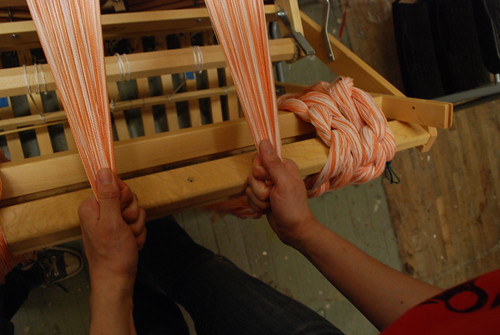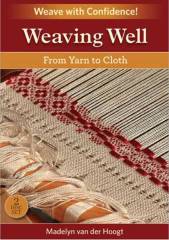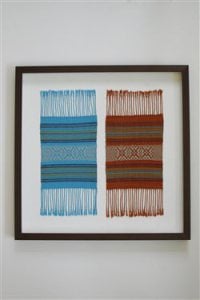Our Blog

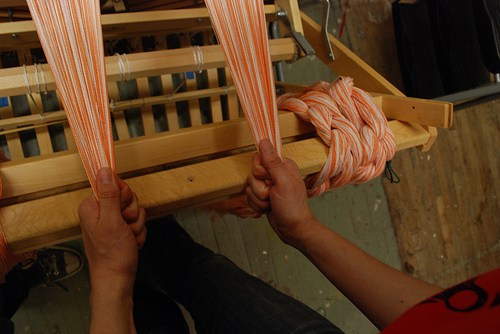
Help for Beginning Weavers: Avoiding Common Pitfalls
As a beginning weaver there are some pitfalls to be avoided. While getting in over one’s head comes right to mind, the reality is that you can make great choices and have success without these dismaying situations.
Yarn choice can have a major impact on the warp tension. While stretchy yarns used for knitting projects are soft and lovely, they are challenging to make into a warp. It is very easy to pull some strands at a different rate than others, often resulting in one side or a part of the warp being tighter that the other. Sometimes, this doesn’t become apparent until well into the weaving. Be extra careful to wind the yarn with an even tension across the whole width of the loom (see the last note below about your physical approach to warping for more on this issue).
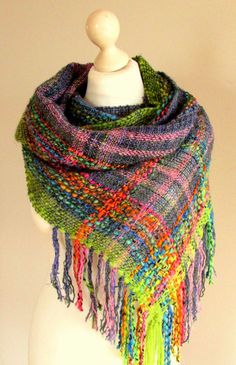 Tactile yarns woven into a mobius cowl.
Tactile yarns woven into a mobius cowl.
As a beginning weaver, you may be tempted by all the glorious, tactile, fuzzy, curly, and 3-dimensional yarns that are available. Test the stickiness of the fibers. Try unwinding it off the ball or cone. If it sticks together, use caution as to where you will use it. While a fuzzy yarn may be SO tempting, it has a tendency to glom onto itself, like a tangle in one’s hair, making a fusion between warp threads. The same is true for the dimensional fibers. Use these yarns for the weft – show them off by making a loose sett – creating a weft-faced fabric.
Another tempting but challenging choice is man-made fiber with metallic threads. Here the yarn can be so slippery that you can’t hang onto it, or it curls to the point of total scramble. While winding them onto a shuttle, keep the ball or cone inside an open length of panty hose or netting. Again, these yarns can be used for the weft by carefully winding them onto stick shuttles and highlighting their beauty as a weft.
 Cotton Chenille Yarn
Cotton Chenille Yarn
A yarn with a life of its own is chenille. It will actually spit out “worms” i.e. loopy kinks on the surface of your woven fabric! Wait ‘til you have more experience under your belt before trying one of these. We don't want to scare you (though Halloween is just around the corner!) but it's important to consider what kind of yarn you will use for your first warp and weft.
Mixing yarns in a warp is another pitfall. Using more than one type of yarn in the same warp, or mixing a smooth yarn with a lumpy one is problematic. Because yarns with different weights are taken up by the weaving at different rates, unevenness develops in the warp strands. This makes for bunches of loose warp threads. Looms with double back beams are designed to manage this issue. One kind of yarn is wound on one of the beams and the other yarn is wound on the other beam. With a smooth warp, alternate these fancy yarns with plain ones in the weft.
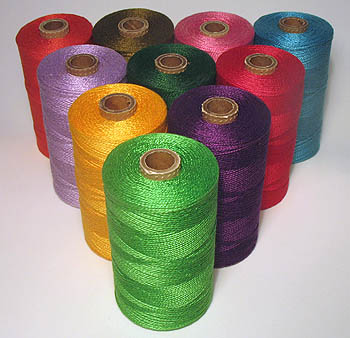 Mercerized Perle Cotton Yarn.
Mercerized Perle Cotton Yarn.
So what’s the best yarn to begin warping? Perle cottons and rug warp are very even and smooth. They are easy to manage and slip through heddles and reeds. With a myriad of colors and weights, it could take years to explore all the possible combinations. After working with these “training” wheel yarns for your warp, you will easily manage some of the more exciting yarn choices above.
Finally, patience is the key to an even warp tension. While measuring your yarn, slow down and keep an even hand while winding. Begin with a calm sense; if you’re tense and thinking of something you need to do, you’ll find your tension changing. Take a break, make a note of the niggling little job or idea that popped into your head, and maybe even take a little walk to resolve your stress. If you are interrupted, try to create the same frame of mind upon your return. If you can, find a helper - a second set of hands to assist you with the juggling required. If you don’t have a helper, click here to read our blog post sharing our best weaving book and DVD recommendations to get you back on track.
Chris, Nancy, and the entire Woolery team!

